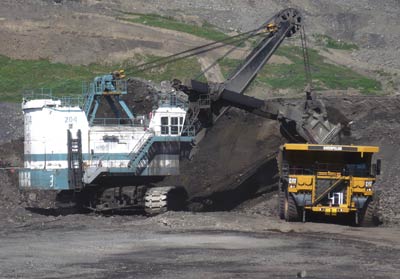 Mining companies interested in estimating the potential economic benefits of introducing ore pre-concentration technology can take advantage of a free evaluation tool called PreCalculatOre commissioned by the Sudbury-based Centre for Excellence in Mining Innovation (CEMI).
Mining companies interested in estimating the potential economic benefits of introducing ore pre-concentration technology can take advantage of a free evaluation tool called PreCalculatOre commissioned by the Sudbury-based Centre for Excellence in Mining Innovation (CEMI).
The software application was co-developed by MineSense Technologies Ltd. of Vancouver and Xstrata Process Support, a Sudbury-based metallurgical engineering and technology subsidiary of Xstrata Technology Services.
The decision to fund the development of an evaluation tool came about as a result of a CEMI-sponsored workshop aimed at identifying research opportunities.
“It seemed evident to us that encouraging mining companies to look at pre-concentration techniques made sense, so we brought together mining company representatives, academics and experts in ore pre-concentration to find out where the research gaps were,” said Damien Duff, CEMI’s R&D program director.
“To be quite frank, they struggled to tell us where the research gaps were because the technology is already quite well-known and proven. It just needs to be adopted, so the real opportunity was to try to figure out a way to get mining company executives interested in it.”
Energy savings
Ore pre-concentration reduces energy and transportation costs, and shrinks the footprint of a mining operation because there’s less waste to dispose of on surface.
“Ventilation is far and away the biggest cost in terms of energy incurred by underground mines, but the second highest cost is associated with hoisting ore to surface, and once you get into the mill, there’s a huge energy cost associated with grinding the ore,” said Duff.
“However, if you can reduce the amount of material that you have to hoist from underground, and if you can also reduce the amount of material that’s going into the mill, you can lower your costs associated with both hoisting and grinding, so there’s a double benefit of cost reduction if you pre-concentrate the ore.”
Several mining companies in northeastern Ontario are in the process of spending money to acquire ore pre-concentrating technology on surface. However, until now, Canadian mining companies have shied away from pre-concentration.
“Normally, when you talk to a mining company about pre-concentration, it’s perceived as a cost and as a metal loss,” said Andrew Bamber, CEO of MineSense Technologies. “Once the concept of pre-concentration as a cost and a metal loss is embedded in the mind of the client, the discussion doesn’t go very much further.”
However, PreCalculatOre demonstrates that the savings can more than compensate for the cost of pre-concentration technologies.
Ore pre-concentration is more common in other jurisdictions.
The Australian mining community, for example, has more of a “try it and see” culture and is more open to innovation, said Bamber, while South African mines have been forced to invest in pre-concentration because of the cost of hoisting low grade ore from extreme depths.
Pressure to innovate
“The situation in Canada is a little bit different,” said Bamber. “Until recently, Canadian mines have been mining grades that other countries would dream of having. Now that grades are falling and costs are rising, there’s more pressure to innovate.”
The Canadian mining industry is also overcoming a “first to be second mentality,” he said.
“Unless somebody else in Canada, who is well-known and established, is actually doing it in exactly the same scenario, they will be resistant to even believing that it’s possible, so it’s an innovation culture that needs to evolve as well.”
Pre-concentration technology employs sensors to separate ore from waste based on the electrical, electro-magnetic and optical properties of the material.
Deploying pre-concentration technology on surface is less of a stretch for mining companies, but the optimal benefits are achieved by pre-concentrating as close to the face as possible, said Duff. Pre-concentration underground optimizes the metal carrying capacity of the hoisting system and keeps waste underground, where it can be used as backfill in stopes.
Retrofitting an existing underground mine to accommodate pre-concentration isn’t as challenging as some might expect. A MineSense study at Vale’s McCreedy East Mine demonstrated that “there are sufficient pre-existing excavations, ore passes, bins and transfer points to allow the retrofitting for pre-concentration fairly easily,” said Bamber. “The whole idea of underground or surface concentration is that it integrates with a mine’s existing material handling system.”
PreCalculatOre does nothing other than “outline the possible benefits associated with the whole notion of pre-concentration,” said Duff.
“It’s a very high-level, back of the envelope type tool designed to do nothing other than create interest and awareness of the possible benefits of pre-concentration. It’s not designed to give you feasibility or even pre-feasibility study numbers that you can hang your hat on.”
Users of the tool input the size of their resource in tonnes, the number of operating days, metal grades, metal prices, the depth of the mine, the distance between the mine and mill and other information. The application estimates the impact of pre-concentration in terms of operating costs and revenue per tonne with an accuracy of plus or minus 40 per cent.
“The purists will complain, but a feasibility study is only plus or minus 15 per cent at best, so for a tool we’re making available free of charge on our website, companies can settle for plus or minus 40 per cent and fund the detailed work after that themselves,” said Duff.
The application is available as a free download from both the CEMI and MineSense websites.
www.miningexcellence.ca
www.minesense.com

